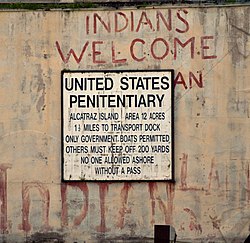| Occupation of Alcatraz | |||
|---|---|---|---|
| Part of Red Power movement and political violence in the United States | |||
 Markings from the occupation of Alcatraz as it appeared in 2010 | |||
| Date | November 20, 1969 – June 11, 1971 (1 year, 6 months and 22 days) | ||
| Location | 37°49′36″N 122°25′22″W / 37.82667°N 122.42278°W | ||
| Caused by | Violations of the Treaty of Fort Laramie | ||
| Goals | Awareness of American Indian oppression | ||
| Parties | |||
| |||
| Lead figures | |||
Leonard Garment | |||
| Number | |||
| |||
| Casualties | |||
| Death(s) | One (accidental) | ||

The Occupation of Alcatraz (November 20, 1969 – June 11, 1971) was a 19-month long occupation by 89 Native Americans and their supporters of Alcatraz Island and its prison complex, classified as abandoned surplus federal land.[1] The occupation was led by Richard Oakes, LaNada Means, and others, while John Trudell served as spokesman. The group lived on the island together until the occupation was forcibly ended by the U.S. government.
The protest group chose the name Indians of All Tribes (IAT) for themselves.[1] IAT claimed that, under the Treaty of Fort Laramie (1868) between the U.S. and the Lakota tribe, all retired, abandoned, or out-of-use federal land was to be returned to the Indigenous peoples who once occupied it. As Alcatraz penitentiary had been closed on March 21, 1963, and the island had been declared surplus federal property in 1964, a number of Red Power activists felt that the island qualified for a reclamation by Indians.
The Occupation of Alcatraz had a brief effect on federal Indian Termination policies and established a precedent for Indian activism. Oakes was later shot to death in 1972, and the American Indian Movement was to be targeted by the federal government and the FBI in COINTELPRO operations.
- ^ a b Kelly, Casey Ryan (2014). "Détournement, Decolonization, and the American Indian Occupation of Alcatraz Island (1969–1971)". Rhetoric Society Quarterly. 44 (2): 168–190. doi:10.1080/02773945.2014.888464. S2CID 143586269.